 In Southport, NC, a cormorant dried his wings right next to our spot at the town dock. It has been two warm and beautiful days, almost seventy degrees. We're busy doing a number of things to prepare ourselves and the boat for another offshore adventure. We'll either go down the coast from here, to Charleston, Fernandina Beach, or Ft. Pierce, or if the weather permits, we'll cross the Gulf Stream and make it to the Bahamas. We can almost feel the warm sand, but it will take a while to get there. Merry Christmas to all!
In Southport, NC, a cormorant dried his wings right next to our spot at the town dock. It has been two warm and beautiful days, almost seventy degrees. We're busy doing a number of things to prepare ourselves and the boat for another offshore adventure. We'll either go down the coast from here, to Charleston, Fernandina Beach, or Ft. Pierce, or if the weather permits, we'll cross the Gulf Stream and make it to the Bahamas. We can almost feel the warm sand, but it will take a while to get there. Merry Christmas to all!
Monday, December 18, 2006
 In Southport, NC, a cormorant dried his wings right next to our spot at the town dock. It has been two warm and beautiful days, almost seventy degrees. We're busy doing a number of things to prepare ourselves and the boat for another offshore adventure. We'll either go down the coast from here, to Charleston, Fernandina Beach, or Ft. Pierce, or if the weather permits, we'll cross the Gulf Stream and make it to the Bahamas. We can almost feel the warm sand, but it will take a while to get there. Merry Christmas to all!
In Southport, NC, a cormorant dried his wings right next to our spot at the town dock. It has been two warm and beautiful days, almost seventy degrees. We're busy doing a number of things to prepare ourselves and the boat for another offshore adventure. We'll either go down the coast from here, to Charleston, Fernandina Beach, or Ft. Pierce, or if the weather permits, we'll cross the Gulf Stream and make it to the Bahamas. We can almost feel the warm sand, but it will take a while to get there. Merry Christmas to all!
 On December 12, we left Oriental, bound for Swansboro. Close to Beaufort, NC, we broke a fan belt and didn't have a spare. We got a tow into Beaufort and lots of help from the local TowBoat / US operator there in locating a new belt. Now we have a spare. It was a new and interesting problem to install the belt, involving taking the alternator mostly off, but finally we were on our way. We stayed two nights at Swansboro, waiting out some chilly, drizzly, foggy days. We also had had a new fuel hose shipped to Swansboro and installed that there. Then we made our way to Southport, NC, close to the Cape Fear inlet, on December 17.
On December 12, we left Oriental, bound for Swansboro. Close to Beaufort, NC, we broke a fan belt and didn't have a spare. We got a tow into Beaufort and lots of help from the local TowBoat / US operator there in locating a new belt. Now we have a spare. It was a new and interesting problem to install the belt, involving taking the alternator mostly off, but finally we were on our way. We stayed two nights at Swansboro, waiting out some chilly, drizzly, foggy days. We also had had a new fuel hose shipped to Swansboro and installed that there. Then we made our way to Southport, NC, close to the Cape Fear inlet, on December 17.
 We finally made it to Oriental, NC on December 5. We spent some time with our friends, fellow Baba- owners, Joe and Priscilla Brant. While we were there, another cold front with strong winds was predicted to come through, and Joe found a slip for us to hole up in and wait it out. It turned out to be the coldest weather yet this year, with two days of lows in the 20s, breaking records around the area. We were very grateful to have heat and stay put in this wonderful spot, with a lounge area that looked like a mountain lodge.
We finally made it to Oriental, NC on December 5. We spent some time with our friends, fellow Baba- owners, Joe and Priscilla Brant. While we were there, another cold front with strong winds was predicted to come through, and Joe found a slip for us to hole up in and wait it out. It turned out to be the coldest weather yet this year, with two days of lows in the 20s, breaking records around the area. We were very grateful to have heat and stay put in this wonderful spot, with a lounge area that looked like a mountain lodge.
Thursday, December 14, 2006

 On December 3, we left Belhaven bound for Oriental, NC. After a bouncy ride across Pamlico Sound, we entered the canal. By the time we crossed the canal into the Neuse River, the skies were looking gray and the wind had come up. We turned around and spent two nights at the R E Mayo shrimp boat dock, alongside commercial shrimp boats. We waited out the cold front in this protected spot and had a delightful dose of local color from the off-season fish company. Accomodations were a bit dilapidated, and I avoided the ladies' room pictured below.
On December 3, we left Belhaven bound for Oriental, NC. After a bouncy ride across Pamlico Sound, we entered the canal. By the time we crossed the canal into the Neuse River, the skies were looking gray and the wind had come up. We turned around and spent two nights at the R E Mayo shrimp boat dock, alongside commercial shrimp boats. We waited out the cold front in this protected spot and had a delightful dose of local color from the off-season fish company. Accomodations were a bit dilapidated, and I avoided the ladies' room pictured below.
 We left Elizabeth City on November 29, and crossed the Albemarle Sound on a beautiful calm day. We anchored in a peaceful bend on the Alligator River. There we noticed diesel fuel in our engine pan (again!). We had to limp back to the Alligator River Marina and contact AYB again. After some prodding, and calling Yanmar directly, they did send down a mechanic to look at the engine. A pin hole leak in a high-pressure fuel line was found, and he could jury-rig it up to work. We left the marina after a cold front went through the area on December 2.
We left Elizabeth City on November 29, and crossed the Albemarle Sound on a beautiful calm day. We anchored in a peaceful bend on the Alligator River. There we noticed diesel fuel in our engine pan (again!). We had to limp back to the Alligator River Marina and contact AYB again. After some prodding, and calling Yanmar directly, they did send down a mechanic to look at the engine. A pin hole leak in a high-pressure fuel line was found, and he could jury-rig it up to work. We left the marina after a cold front went through the area on December 2.

 On November 26 and 27, we motored through the Dismal Swamp Canal in Virginia and North Carolina. There wasn't anything dismal at all about it, on sunny, calm days, after a bit of fog in the morning. We tied up at the Visitor Center for the night, and made it to Elizabeth City, NC on November 27, where we stayed for two days.
On November 26 and 27, we motored through the Dismal Swamp Canal in Virginia and North Carolina. There wasn't anything dismal at all about it, on sunny, calm days, after a bit of fog in the morning. We tied up at the Visitor Center for the night, and made it to Elizabeth City, NC on November 27, where we stayed for two days.


 At Atlantic Yacht Basin in Ches- apeake, we had a new bow roller installed, our engine checked over once again for any leaks, and a new stainless plate through- bolted for strength. A small yard worker had to get into our anchor locker through the V-berth (our bedroom!) all the way forward, and work had to be done on the bow of the boat. We ended up with a much better system that we think will withstand much greater stresses.
At Atlantic Yacht Basin in Ches- apeake, we had a new bow roller installed, our engine checked over once again for any leaks, and a new stainless plate through- bolted for strength. A small yard worker had to get into our anchor locker through the V-berth (our bedroom!) all the way forward, and work had to be done on the bow of the boat. We ended up with a much better system that we think will withstand much greater stresses.We also got strong three-fourths inch nylon three-strand line, and learned how to splice a steel thimble eye into it. We added a stainless shackle and chain hook for a heavy-duty snubbing line, to be used with the chain at anchor.
We left Chesapeake on November 26, headed for the Dismal Swamp Canal.
Saturday, November 25, 2006

 On Saturday, November 11, we sailed back to Norfolk. Larry had gotten the engine working again, and we had a very nice south-west breeze to sail back with. The sun was setting as we spotted the entrance buoys to the inlet, and we motored the long way back in the inlet in the dark. The weather forecast was for south and east winds of 20-25 knots after midnight into the next day, so we anchored in the south-east corner of Willoughby Bay to get protection from the winds forecast. We dropped anchor just before midnight, let out 90 feet of anchor chain, and battened everything down for a breezy night.
On Saturday, November 11, we sailed back to Norfolk. Larry had gotten the engine working again, and we had a very nice south-west breeze to sail back with. The sun was setting as we spotted the entrance buoys to the inlet, and we motored the long way back in the inlet in the dark. The weather forecast was for south and east winds of 20-25 knots after midnight into the next day, so we anchored in the south-east corner of Willoughby Bay to get protection from the winds forecast. We dropped anchor just before midnight, let out 90 feet of anchor chain, and battened everything down for a breezy night.The wind, when it came up, was instead from the northwest, blowing directly across the bay, allowing the waves to build. By mid-morning it was a full gale of 35-40 knots, blowing sheets of rain across us. Our anchor was holding well, but it was a wild ride. It did not start subsiding until Monday morning, when the wind was down to about 15-20 knots, with a steel-gray sky. We decided to pull up our anchor and get going down to the boatyard.
The force of the wind and water on the anchor was hard to describe; in hindsight, we should have waited one more day for the wind to die down before moving. Using the engine to help motor up to the anchor, and our windlass, Larry tried to get the anchor up. The bow roller that guides the anchor chain started to flex as the chain came in, something we had never seen before. Finally the roller twisted into the shape pictured above. Larry also got his hand caught between the chain and the post, crushing a finger, even as careful as he could be. Things just happen very quickly when the wind is blowing. He could have lost a finger very easily. The anchor wouldn't come up, when we came to the end of the chain; it was solidly set and wouldn't budge.
At that point we were in a real predicament. The roller was compromised and could shear off at any moment; the bow of the boat was bucking like a bronco; and we knew if the roller came off, the anchor chain would start to take out the bow of the boat. We could lose the boat quite easily. We tried to hail TowBoat/US on the VHF radio, but they didn't answer. Neither did anyone else. So, we used the ham radio to contact Maritime Radio 14300 KHz, who saved the day. They contacted TowBoat/US for us and put us in a patch via the radio to them. It turns out they were on another emergency call and couldn't get to us for over 2 hours. So we braced the bow as well as we could and waited. Finally, the motion of the boat broke the anchor free, and we carefully raised it and lashed the anchor in the twisted roller.
We held our breath with every rolling wave that washed over us and motored down to Great Bridge. In the morning, the boatyard was extremely accomodating, cleaning up the diesel in our bilge, and even replacing our bow roller. We also had their machine shop put a steel plate to reinforce the bow roller.
Things could have been much worse, as we read up on bow rollers and their vulnerabilities and importance in an anchoring system. We got several good lessons in safety at very little cost.
Thursday, November 23, 2006

Friday night, November 10, about 22:00 hours and still becalmed about 80 miles south-east of Hampton Roads, I noticed a vessel's lights and started tracking it. What we do is take hand-held compass bearings on vessels; if the compass bearing relative to our own course does not change, and especially if it becomes larger, we need to take action to prevent a collision. We were completely becalmed with no wind. First I tried to hail them on VHF radio, channel 16, with no answer. Then, as we became increasingly concerned, we decided to turn on the motor and get out of the way ourselves; as a sailing vessel, we do have right of way, but that is often ignored on the high seas. The engine started, then sputtered, and died. It would not restart and sounded starved of fuel. We thought we had close to a full tank.
The priority now was to draw attention to ourselves. We got out our big spotlight, shone the light on the main sail, and also pointed the beam straight out at the ship. That got their attention and they changed course. We realized we were on the south and west side of the Gulf Stream, and shipping heading south will use this corridor to get out of the Stream's pull north-east.
Now we had to figure out the engine. On taking the cover off, we immediately spotted diesel fuel - the engine pan was full, and the bilge under the engine was full of pink diesel fuel. We spotted the secondary fuel filter casing, which was just hanging on by a thread. After our engine work in Chesapeake, the mechanic had neglected to tighten up the fuel filter casing, and our tank's diesel fuel had dribbled out into the pan and overflowed into the bilge. The bilge pump had probably gone on while we were motoring out the inlet and we hadn't heard it. We had just lost over three-quarters of all the diesel fuel we brought with us. The fuel canister is pictured above, after we tightened it.
After tightening the fuel filter, we used our new sipon pump to put a jerry jug of diesel from our deck jugs into the main tank, tried to bleed the engine of air, and restart. No go that night, and after discussing our options, we decided we had to turn back. Without enough back-up diesel to use and only 80 miles out, we had lost our ability to motor for a day or two if we needed to, in a storm or calms. So we reluctantly turned our bow north west and waited for some wind.
The next morning we reported in on our ham radio to the Waterway Radio Club and talked to our friend Rick in Charleston. We had him call TowBoat/US to alert them of our condition (engine won't start and no wind), and had him call the boatyard where the work was done. As the wind filled in that day, we had a fine sail back to Norfolk, while Larry worked on the engine. After bleeding the injectors, he finally got it started. We transferred all fuel in jerry jugs on deck (about 22 gallons) into the tank for our motor in the inlet.

 On Friday, November 10, our breeze died in the afternoon. We rolled up the jib, pointed our bow southeast, and tracked the swell, which was taking us very slowly in the right direction. We had an unexpected visitor; about 50 miles offshore, a red-winged blackbird came onto the boat. Here he is about mid-ships, looking at our fuel jugs and folding dinghy. We offered him a bowl of fresh water and a cracker, but he ignored us. The forecast was for the wind to fill in from the south-west on Saturday morning, so we left the motor off to conserve our fuel. We only carry about 2-3 days of fuel for motoring and need to carefully weigh when to "turn the key" and motor.
On Friday, November 10, our breeze died in the afternoon. We rolled up the jib, pointed our bow southeast, and tracked the swell, which was taking us very slowly in the right direction. We had an unexpected visitor; about 50 miles offshore, a red-winged blackbird came onto the boat. Here he is about mid-ships, looking at our fuel jugs and folding dinghy. We offered him a bowl of fresh water and a cracker, but he ignored us. The forecast was for the wind to fill in from the south-west on Saturday morning, so we left the motor off to conserve our fuel. We only carry about 2-3 days of fuel for motoring and need to carefully weigh when to "turn the key" and motor.


 On the afternoon of Thursday, November 9, we sailed out the Hampton Roads inlet into the Atlantic Ocean, headed again towards Bermuda and the eastern Caribbean. As we motor-sailed past the US Navy base, the submarines, aircraft carriers, and battleships were bathed in the rosy glow of sunset. We had spent the night before at the Portsmouth Boating Center, stowing everything below and tightening all straps, inspecting sails and rigging. It was a fine day, with a westerly breeze, with a good forecast of a south-westerly wind the next day, after a low-pressure system had moved out to sea. We had an uneventful first night out and headed south-east.
On the afternoon of Thursday, November 9, we sailed out the Hampton Roads inlet into the Atlantic Ocean, headed again towards Bermuda and the eastern Caribbean. As we motor-sailed past the US Navy base, the submarines, aircraft carriers, and battleships were bathed in the rosy glow of sunset. We had spent the night before at the Portsmouth Boating Center, stowing everything below and tightening all straps, inspecting sails and rigging. It was a fine day, with a westerly breeze, with a good forecast of a south-westerly wind the next day, after a low-pressure system had moved out to sea. We had an uneventful first night out and headed south-east.
Thursday, November 16, 2006


 Our friend Diana from Charleston drove up to visit us just before we left Ches- apeake, VA. We had a lovely visit, including a dinner party with steaks aboard a friend's boat. I had missed her a great deal and so much appreciated the visit. Diana and I took a walk in crisp, sunny, fall weather over to the locks park too.
Our friend Diana from Charleston drove up to visit us just before we left Ches- apeake, VA. We had a lovely visit, including a dinner party with steaks aboard a friend's boat. I had missed her a great deal and so much appreciated the visit. Diana and I took a walk in crisp, sunny, fall weather over to the locks park too.
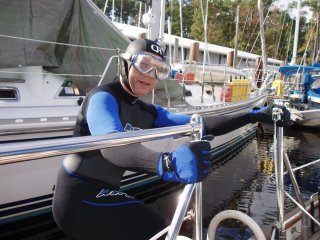 The last two weeks of October were spent in a flurry of activity preparing the boat and ourselves to go offshore. One of the tasks that Larry took on was to suit up and dive on the bottom of the boat to scrape off growing weeds, barnacles, and replace zincs. The weather was chilly, in the 50s, so a hot shower here at the boatyard was a welcome end to the job.
The last two weeks of October were spent in a flurry of activity preparing the boat and ourselves to go offshore. One of the tasks that Larry took on was to suit up and dive on the bottom of the boat to scrape off growing weeds, barnacles, and replace zincs. The weather was chilly, in the 50s, so a hot shower here at the boatyard was a welcome end to the job. We also had provisions to buy, last-minute purchases at West Marine and Boater's World, and everything on the boat had to be stowed and secured for any weather. The list of small tasks that needed to be done seemed enormous, but finally we got it all done.
We also had provisions to buy, last-minute purchases at West Marine and Boater's World, and everything on the boat had to be stowed and secured for any weather. The list of small tasks that needed to be done seemed enormous, but finally we got it all done.
Wednesday, November 15, 2006

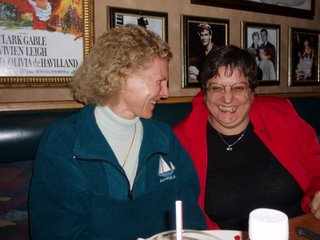
 In October, we took a short trip back to Minnesota to visit family and friends. We celebrated Debby's mom's 81st birthday. It was a wonderful time to be in Minnesota, with the leaves starting to turn color. We had every sort of weather, from temperatures in the 80s to the 20s, with a sprinkling of snow too. We headed back to Viriginia to get the boat and ourselves ready for another offshore voyage to the eastern Caribbean. We planned to start looking for a good weather window after November 1, when the hurricane season is winding down.
In October, we took a short trip back to Minnesota to visit family and friends. We celebrated Debby's mom's 81st birthday. It was a wonderful time to be in Minnesota, with the leaves starting to turn color. We had every sort of weather, from temperatures in the 80s to the 20s, with a sprinkling of snow too. We headed back to Viriginia to get the boat and ourselves ready for another offshore voyage to the eastern Caribbean. We planned to start looking for a good weather window after November 1, when the hurricane season is winding down.
Sunday, September 17, 2006
 Here's our trusty little Yanmar diesel engine, which is located right between our galley (kitchen) and navigation station. On September 1, with rain from Ernesto coming down in sheets, a master mechanic from Atlantic Yacht Basin came over to fix our engine. It was all done by mid-day.
Here's our trusty little Yanmar diesel engine, which is located right between our galley (kitchen) and navigation station. On September 1, with rain from Ernesto coming down in sheets, a master mechanic from Atlantic Yacht Basin came over to fix our engine. It was all done by mid-day.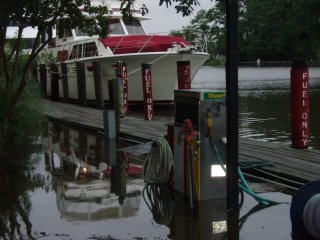
 The rest of the rainy day, we ventured around the boatyard, where over 2 feet of water had accum- ulated. The roads were also full of water for the next two days, but slowly subsided.
The rest of the rainy day, we ventured around the boatyard, where over 2 feet of water had accum- ulated. The roads were also full of water for the next two days, but slowly subsided.After thinking about our options for the rest of the hurricane season, and talking to the staff here and other boaters, we decided to stay at Atlantic Yacht Basin for the next two months. We have a trip planned to Minnesota to visit family and friends for two weeks, and know that the boat will have good protection for any other storms headed this way while we are gone.

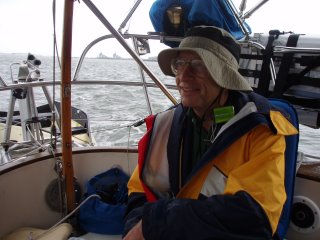
 After the night of August 31 spent in Norfolk's Willoughby Bay, with the wind rising to 25-30 knots due to Tropical Storm Ernesto, we tried to start our engine and get underway. We needed to get to a more protected spot and were going to head to the Dismal Swamp Canal to ride out the storm. Our engine had other ideas, and the oil pressure light came on solid. We shut it down immediately and investigated. There was no oil in the crankcase, and all of it was in the pan under the engine. We determined that the problem was caused by some work we had had done a month ago. With the storm approaching, we decided to use our towing insurance and call TowBoat/US for a tow back to the boatyard where the work had been done. Here you can just make out the tow boat and tow line, and see the deteriorating weather in the clouds. It was a rainy, windy, and rolly ride, twelve miles down the Elizabeth River, past US Navy warships and commercial container ships, and took four hours. We were very happy to be tied up at a protected dock for the storm.
After the night of August 31 spent in Norfolk's Willoughby Bay, with the wind rising to 25-30 knots due to Tropical Storm Ernesto, we tried to start our engine and get underway. We needed to get to a more protected spot and were going to head to the Dismal Swamp Canal to ride out the storm. Our engine had other ideas, and the oil pressure light came on solid. We shut it down immediately and investigated. There was no oil in the crankcase, and all of it was in the pan under the engine. We determined that the problem was caused by some work we had had done a month ago. With the storm approaching, we decided to use our towing insurance and call TowBoat/US for a tow back to the boatyard where the work had been done. Here you can just make out the tow boat and tow line, and see the deteriorating weather in the clouds. It was a rainy, windy, and rolly ride, twelve miles down the Elizabeth River, past US Navy warships and commercial container ships, and took four hours. We were very happy to be tied up at a protected dock for the storm.
Friday, September 08, 2006
 With the Debonair anchored nearby and us going ashore at their dinghy dock everyday for a small fee, we made ourselves at home at the Capital Yacht Club in Washington. Not the type of place where we usually hang out, but we are definitely flexible. The members were very friendly, opening their facilities to us and providing local knowledge about DC as well as much appreciated rides to food and boat stores for supplies.
With the Debonair anchored nearby and us going ashore at their dinghy dock everyday for a small fee, we made ourselves at home at the Capital Yacht Club in Washington. Not the type of place where we usually hang out, but we are definitely flexible. The members were very friendly, opening their facilities to us and providing local knowledge about DC as well as much appreciated rides to food and boat stores for supplies.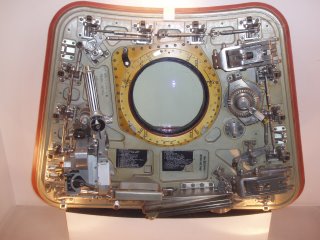 Among the thousands of objects on display in the Smithsonian collections, a hatch door (3 ft x 3 ft) from the Apollo 11 Command Module at the Air and Space Museum was one of the most fascinating to me. It shows the engineering complexity of advanced technology used in space flight, yet it's also composed and framed like a work of art.
Among the thousands of objects on display in the Smithsonian collections, a hatch door (3 ft x 3 ft) from the Apollo 11 Command Module at the Air and Space Museum was one of the most fascinating to me. It shows the engineering complexity of advanced technology used in space flight, yet it's also composed and framed like a work of art. This colorful "flower garden" constructed of wood and designed geo- metrically was a favorite at the Hirschhorn Museum.
This colorful "flower garden" constructed of wood and designed geo- metrically was a favorite at the Hirschhorn Museum.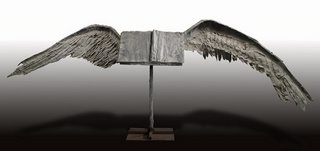
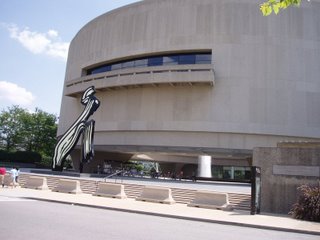
There was also a challenging exhibit of painting and sculpture by the German artist Anselm Kiefer, in a far more somber mood as shown by his preferred color, grey, and material, lead.
Larry
Friday, September 01, 2006

We spent almost three weeks in Washington, DC, visiting many museums, the outdoor monuments, the zoo, art galleries, and many more sights. The Smithsonian's buildings alone could have afforded much more time for a complete viewing. We took subways, buses, and walked many miles in DC.
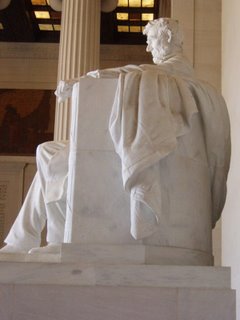

The National Gallery of Art, the Hirschhorn, the Air and Space Museum, and the American History Museum were our favorites, with more than one visit each. We toured the Capitol, the Library of Congress, the National Archives, the Supreme Court, and took a bus to the National Cathedral. We could have spent much more time than we did in DC, but were quickly approaching saturation level with being tourists.
We had several wonderful running sessions in DC also - where else could we start a run going to the Jefferson Memorial, and take in the FDR, Korean War, Vietnam Veterans, WWII, Lincoln Memorial, and the Washington Monument, all in one run?

The security in most places was noticeably more strict - we went through metal detectors, had our bags inspected, and had to throw away water bottles in most places. The Capitol and White House especially have barriers up and strict protocol in how to tour. No cars can pass down Pennsylvania Avenue in front of the White House, and no tours are given except one day a year.
We had exceptional weather while in DC also - sunny skies, in the 80s, and one one day with rain.
-Debby

Monday, August 14, 2006
 Washington, D.C. We've been anchored in the Potomac at the Capital Yacht Club for the past week. Ideal location for taking in sights like the Smithsonian museums and area monuments (Washington spire in background). Unfortunately our anchorage is situated on the flight path between the White House and nearby airports. So several times each day we are buzzed by low flying police and Presidential helicopters whose official occupants no doubt view us with the same mix of curiosity and suspicion that we have for them.
Washington, D.C. We've been anchored in the Potomac at the Capital Yacht Club for the past week. Ideal location for taking in sights like the Smithsonian museums and area monuments (Washington spire in background). Unfortunately our anchorage is situated on the flight path between the White House and nearby airports. So several times each day we are buzzed by low flying police and Presidential helicopters whose official occupants no doubt view us with the same mix of curiosity and suspicion that we have for them.
Thursday, August 10, 2006

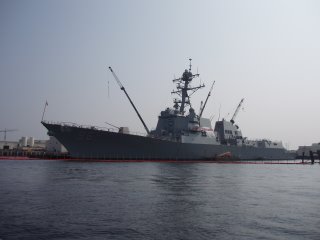 Sailing past Norfolk, VA, the commercial shipping and Navy shipbuilding and refurbishing is quite extensive. It took almost an hour to motor past all of the activity in Norfolk, on an almost windless, hot day.
Sailing past Norfolk, VA, the commercial shipping and Navy shipbuilding and refurbishing is quite extensive. It took almost an hour to motor past all of the activity in Norfolk, on an almost windless, hot day.Norfolk and Hampton, Virginia are at the crossroads of several waters, including the Elizabeth and Hampton Rivers, Hampton Roads, and the Chesapeake, so we planned our passage for as calm a day as possible.

Saturday, July 29, 2006
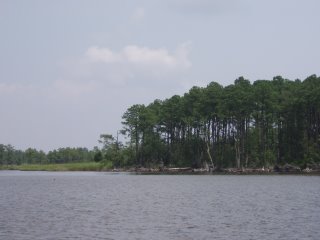
 A view of the IntraCoastal Waterway in North Carolina. We passed many scenes like this at our snail's pace of 5 - 6 knots, or about 7 mph. The post is an Aid to Navigation (ATON) to tell boaters where the channel is. Outside of the channel might be only a foot or two of water. We saw many osprey nests in the ATONs, with large teenage ospreys cheeping plaintively for their parents to bring them food.
A view of the IntraCoastal Waterway in North Carolina. We passed many scenes like this at our snail's pace of 5 - 6 knots, or about 7 mph. The post is an Aid to Navigation (ATON) to tell boaters where the channel is. Outside of the channel might be only a foot or two of water. We saw many osprey nests in the ATONs, with large teenage ospreys cheeping plaintively for their parents to bring them food.
Subscribe to:
Posts (Atom)



